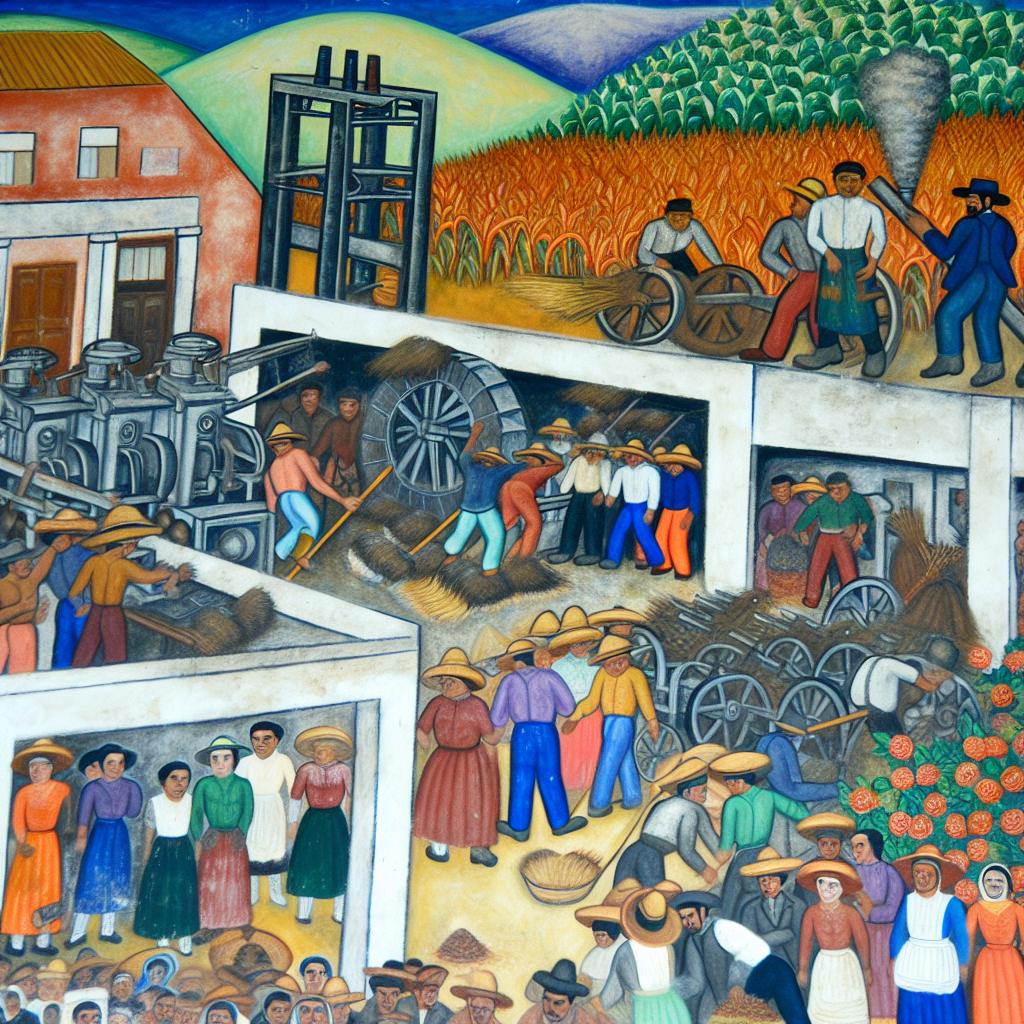The Historical Significance of Diego Rivera’s Murals
Diego Rivera, a prominent Mexican artist in the 20th century, is celebrated for his extensive contributions to muralism. His works not only showcase his artistic prowess but also serve as a vital tool for preserving and communicating history. The murals of Rivera hold significant cultural and historical value, playing a crucial role in reflecting the social and political transformations of the time.
Depiction of Mexican History
Rivera’s murals provide a visual narrative of Mexican history, focusing on the pre-Columbian era, colonial period, and the Mexican Revolution. Through his art, Rivera sought to educate the public about the richness of Mexico’s past. His works, such as the murals in the National Palace of Mexico City, meticulously detail events and figures crucial to understanding the nation’s heritage. His depiction of history was not just about representing events and figures; it was about emphasizing a continuous cultural identity that resonates with the shared heritage of the Mexican population.
Take, for instance, the mural series “The History of Mexico” in the National Palace, where Rivera illustrates pivotal episodes, from the ancient Aztec civilization to the struggles for independence and revolution. Each mural serves as a chapter in the country’s history, intricately connecting the past with the present, providing a visual archive that honors the resilience and spirit of the Mexican people throughout the ages.
Social and Political Commentary
Beyond historical representation, Rivera used his murals as a medium for social and political commentary. He captured the struggles of the working class and indigenous people during the socio-economic upheavals of the early 20th century. By depicting these realities, Rivera challenged viewers to confront issues such as inequality and exploitation, making his murals not only visually compelling but also socially impactful.
For instance, in the mural “Man at the Crossroads”, initially commissioned for the Rockefeller Center in New York City, Rivera explored themes of industry, power, and the contrasting ideologies of capitalism and socialism. This piece emphasized the power dynamics of modern society and encouraged critical thought about human progress and morality. Although it was eventually destroyed due to controversy, it highlighted Rivera’s commitment to using art as a tool for political engagement and discourse.
Accessibility and Public Engagement
Rivera’s work was intended to be accessible to the masses. Unlike traditional art forms confined to galleries and private collections, his murals adorned public spaces, ensuring that a broad audience could engage with his representations of history and society. This approach democratized art, making historical knowledge available to individuals who might otherwise lack access to such information.
The placement of murals in public spaces such as government buildings, universities, and cultural institutions meant they were seen by everyday people. This public interaction fostered a deeper connection between the community and their cultural heritage, ensuring Rivera’s art was not just admired but also discussed and integrated into daily life. By placing the stories of both ordinary citizens and pivotal historical figures within these accessible visuals, Rivera effectively mainstreamed historical awareness.
Educational Influence
The educational aspect of Rivera’s murals cannot be overstated. His works have been used as teaching tools in exploring Mexican culture and history. Educators utilize these murals to foster discussions on the implications of historical events and to inspire critical thought about the past and its influence on contemporary society.
This educational dimension is amplified in educational materials and documentaries which analyze Rivera’s work, examining the context and significance of his portrayals. Students and scholars alike delve into these murals to pull lessons from the social and historical reflections Rivera provided, showcasing the murals not just as art, but as complex educational devices that enrich historical literacy.
Preservation and Restoration
Given their importance, there has been significant effort to preserve and restore Rivera’s murals. Organizations and art conservators work diligently to maintain these works, recognizing that they are invaluable cultural artifacts. These efforts ensure that future generations continue to have the opportunity to explore and learn from Rivera’s visual interpretations of history.
The preservation process involves not only repairing physical damage to the murals caused by aging and environmental factors but also involves digital technology to archive and disseminate detailed imagery and scholarly interpretations. Institutions involved in these efforts understand that preserving Rivera’s murals requires combined historical knowledge and cutting-edge conservation techniques.
Influence Beyond Borders
Rivera’s impact is not limited to Mexico. His work has found resonance globally, inspiring muralists and artists around the world. In regions dealing with social and political challenges, Rivera’s approach to art as a means of social change offers a powerful model.
His distinctive style and thematic focus on the common people’s struggles have inspired public art initiatives worldwide. In the United States, throughout Latin America, and beyond, artists have adopted muralism to engage communities and foster dialogue on social justice, echoing Rivera’s enduring legacy. Mural programs in cities around the world often cite Rivera as an influence, demonstrating the transnational reach of his artistic philosophy.
Conclusion
In conclusion, the importance of Diego Rivera’s murals lies in their ability to encapsulate and preserve history in a manner that is both informative and transformative. By merging art with historical narrative, Rivera has provided a legacy that transcends simple aesthetic appreciation, inviting ongoing reflection on the past and its continued relevance.
The enduring nature of Rivera’s work lies in its intricate ability to invite viewers to question, understand, and learn from history, drawing parallels to the present day. This connection between history, art, and society ensures his murals remain an invaluable cultural and educational asset. Rivera’s artwork stands as a continuous invitation for discourse, reflection, and inspiration, ensuring his position not only as a significant artist of his time but as a timeless contributor to global cultural heritage.
For more information on the life and works of Diego Rivera, you can explore various dedicated resources and archives that delve deeper into his contributions to art and history.







